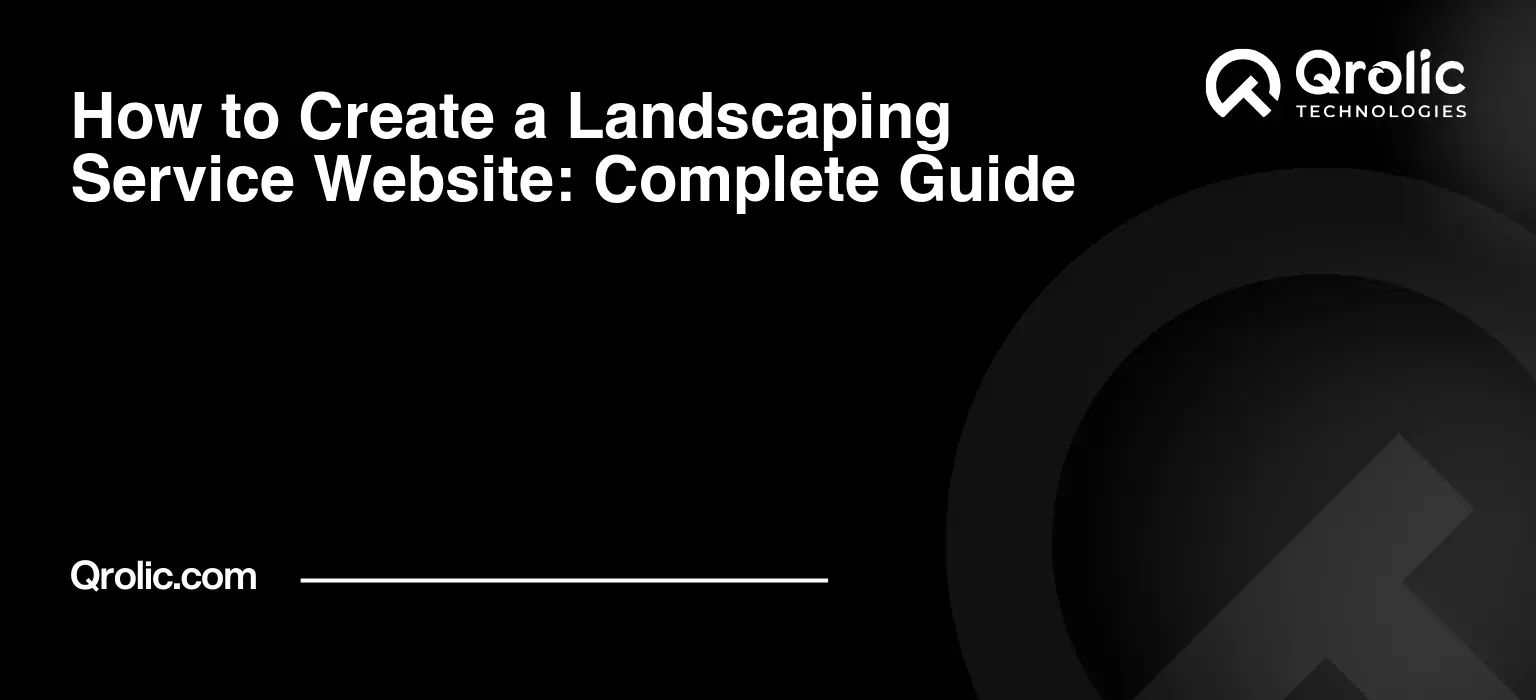Quick Summary:
- Your landscaping business needs a website for growth and trust.
- Plan carefully, design well, and optimize for search engines.
- Showcase your work with stunning, professional photos.
- Ensure your website complies with all legal requirements.
Table of Contents
- Why Your Landscaping Service Needs a Website
- Establishing Credibility and Trust
- Expanding Your Reach and Attracting New Customers
- Showcasing Your Services and Expertise (Outdoor Design Focus)
- Providing Information and Educating Clients
- Facilitating Communication and Customer Service
- Cost-Effective Marketing
- Planning Your Landscaping Service Website: Key Considerations
- Defining Your Target Audience
- Determining Your Website Goals
- Choosing a Domain Name
- Selecting a Web Hosting Provider
- Planning Your Website Structure and Navigation
- Building Your Landscaping Service Website: Step-by-Step Guide
- Choosing a Website Builder or CMS
- Setting Up WordPress
- Designing Your Website
- Creating Compelling Content
- Optimizing Your Website for SEO
- Promoting Your Landscaping Service Website
- Search Engine Optimization (SEO) (Continued)
- Social Media Marketing
- Email Marketing
- Online Advertising
- Local SEO
- Networking
- Maintaining Your Landscaping Service Website
- Regularly Update Your Content
- Perform Security Updates
- Monitor Website Performance
- Back Up Your Website Regularly
- Test Your Website Regularly
- The Importance of Professional Photography for Landscaping Websites
- Showcasing Your Best Work
- Building Trust and Credibility
- Attracting and Engaging Visitors
- Improving SEO
- Driving Conversions
- Types of Photos to Include:
- Qrolic Technologies and Your Landscaping Website
- Our Services:
- Why Choose Qrolic Technologies?
- Legal Considerations for Your Landscaping Service Website
- Privacy Policy
- Terms of Service (Terms and Conditions)
- Copyright Information
- Accessibility
- Disclaimer
- Cookie Policy
- Business Licenses and Disclosures
- Professional Advice
Why Your Landscaping Service Needs a Website

In today’s digital age, a strong online presence is non-negotiable for any business, and landscaping services are no exception. A website serves as your virtual storefront, a 24/7 marketing tool, and a crucial touchpoint for potential and existing clients. But why is a website essential for your landscaping business?
Establishing Credibility and Trust
A professional website instantly boosts your credibility. Think of it as your digital business card. Potential customers are far more likely to trust a company with a well-designed, informative website than one without. It conveys professionalism and demonstrates that you’re serious about your business. Showcase before-and-after photos of your projects; client testimonials singing your praises; and certifications or awards that validate your expertise. These elements build trust and give customers confidence in your ability to deliver exceptional results.
Expanding Your Reach and Attracting New Customers
Your service area is no longer limited to word-of-mouth referrals. A website allows you to reach a much wider audience. Through search engine optimization (SEO), you can attract customers actively searching for landscaping services in your area. Imagine someone Googling “best landscaping service near me” and your website appearing at the top of the results. That’s the power of SEO. Your website acts as a lead generation machine, constantly working to bring in new clients. Use targeted keywords related to outdoor design and local landscaping services to optimize your content.
Showcasing Your Services and Expertise (Outdoor Design Focus)
A website is the perfect platform to showcase the full range of your landscaping services. Beyond just listing them, you can elaborate on your expertise in each area. Emphasize your proficiency in outdoor design. Detail your approach to creating stunning and functional outdoor spaces. Highlight specialized services like:
- Custom Landscape Design: Explain your process, from initial consultation to final implementation, emphasizing your ability to translate clients’ visions into reality.
- Hardscaping: Showcase patios, walkways, retaining walls, and other hardscape features you can create, highlighting the materials you work with and the design possibilities.
- Planting and Garden Design: Detail your knowledge of local plant varieties, your ability to create beautiful and sustainable gardens, and your understanding of soil conditions and irrigation.
- Lawn Care and Maintenance: Explain your lawn care programs, including mowing, fertilization, weed control, and other services that keep lawns healthy and vibrant.
- Outdoor Lighting Design and Installation: Illustrate how you can enhance outdoor spaces with strategic lighting, improving aesthetics and safety.
- Water Features: Highlight your experience with ponds, waterfalls, and other water features, emphasizing the tranquility and beauty they can add to a landscape.
Use high-quality photos and videos to visually showcase your work. Before-and-after shots are especially effective.
Providing Information and Educating Clients
Your website isn’t just a sales tool; it’s also a valuable resource for your clients. You can provide information about:
- Frequently Asked Questions (FAQs): Answer common questions about your services, pricing, and process.
- Informative Blog Posts: Share your expertise on topics like seasonal lawn care, choosing the right plants, or designing sustainable landscapes.
- Tips and Advice: Offer practical tips and advice that homeowners can use to maintain their landscapes.
- Service Area Details: Clearly define the geographic areas you serve.
By providing valuable information, you establish yourself as a trusted authority in the field.
Facilitating Communication and Customer Service
Your website makes it easy for potential and existing clients to contact you. Include a contact form, phone number, email address, and even a live chat feature. This allows you to respond quickly to inquiries, provide quotes, and address customer concerns. A user-friendly website improves customer satisfaction and builds stronger relationships.
Cost-Effective Marketing
Compared to traditional marketing methods like print advertising, a website is a relatively cost-effective marketing tool. Once it’s set up, it can generate leads and attract customers 24/7 without requiring ongoing advertising expenses. Invest in SEO to maximize your website’s visibility and attract organic traffic.
Planning Your Landscaping Service Website: Key Considerations
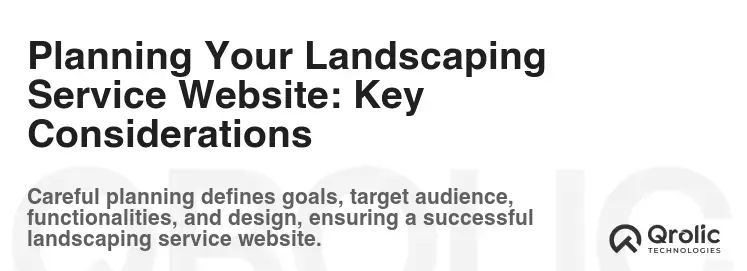
Before you start building your website, take the time to plan it carefully. This will ensure that your website is effective, user-friendly, and achieves your business goals.
Defining Your Target Audience
Who are you trying to reach with your website? Are you targeting homeowners, businesses, or both? What are their needs and expectations? Understanding your target audience is crucial for tailoring your website’s content, design, and marketing efforts. Consider factors like:
- Demographics: Age, income, location, and other demographic characteristics.
- Needs and Pain Points: What problems are they trying to solve with your landscaping services?
- Search Habits: What keywords are they using to find landscaping services online?
- Technology Proficiency: How comfortable are they using the internet and different devices?
Determining Your Website Goals
What do you want your website to achieve? Do you want to generate leads, increase sales, provide customer support, or build brand awareness? Clearly defining your goals will help you measure the success of your website and make informed decisions about its design and content. Some common website goals include:
- Generating Leads: Attracting potential customers who are interested in your services.
- Increasing Sales: Converting website visitors into paying customers.
- Providing Customer Support: Answering customer questions and resolving issues.
- Building Brand Awareness: Increasing recognition of your landscaping business.
- Establishing Authority: Positioning yourself as a trusted expert in the field.
Choosing a Domain Name
Your domain name is your website’s address on the internet. It should be easy to remember, relevant to your business, and available to register. Here are some tips for choosing a domain name:
- Keep it short and memorable: Avoid long, complicated domain names that are difficult to spell or remember.
- Use relevant keywords: Include keywords related to your landscaping services or location.
- Choose the right extension: The most common extension is “.com,” but you can also use “.net,” “.org,” or country-specific extensions.
- Check for availability: Before you register a domain name, make sure it’s available.
- Consider your brand: Your domain name should align with your brand identity.
Selecting a Web Hosting Provider
Web hosting is the service that stores your website’s files on a server and makes it accessible to visitors. Choose a reliable web hosting provider that offers:
- Sufficient Storage and Bandwidth: Ensure your hosting plan can accommodate your website’s files and traffic.
- Fast Loading Speeds: Choose a hosting provider with fast servers and a content delivery network (CDN) to improve website performance.
- Security Features: Look for hosting providers with security features like SSL certificates, firewalls, and malware scanning.
- Reliable Uptime: Choose a hosting provider with a high uptime guarantee to ensure your website is always accessible.
- Good Customer Support: Choose a hosting provider that offers responsive and helpful customer support.
Planning Your Website Structure and Navigation
A well-structured website is easy to navigate and helps visitors find the information they need quickly. Plan your website’s structure and navigation before you start building it. Consider the following:
- Homepage: The main page of your website, which should provide an overview of your services and attract visitors.
- About Us: A page that tells your company’s story, highlights your expertise, and builds trust.
- Services: A page that lists and describes the landscaping services you offer.
- Portfolio/Projects: A page that showcases your past work with photos and descriptions.
- Testimonials: A page that features positive feedback from satisfied clients.
- Blog: A page that contains informative articles and blog posts related to landscaping.
- Contact Us: A page that provides contact information and a contact form.
- Sitemap: A page that lists all the pages on your website, making it easier for search engines to crawl.
Ensure your website’s navigation is clear, intuitive, and consistent across all pages.
Building Your Landscaping Service Website: Step-by-Step Guide
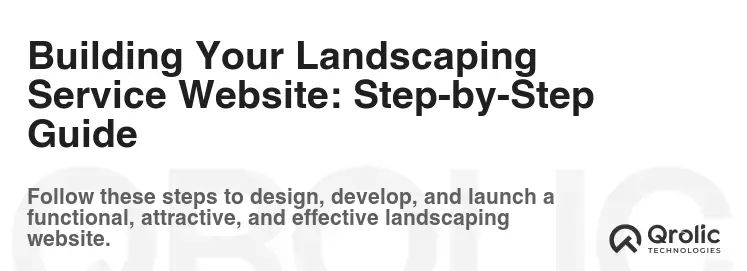
Now that you’ve planned your website, it’s time to start building it. There are several ways to build a website, but the most common options are using a website builder or a content management system (CMS).
Choosing a Website Builder or CMS
- Website Builders (e.g., Wix, Squarespace): These platforms offer drag-and-drop interfaces and pre-designed templates, making it easy for beginners to create a website without coding knowledge.
- Content Management Systems (CMS) (e.g., WordPress, Joomla, Drupal): These platforms offer more flexibility and customization options than website builders, but they require some technical knowledge. WordPress is the most popular CMS, known for its ease of use, extensive plugin library, and SEO-friendly features.
For most landscaping businesses, WordPress is the recommended option due to its:
- Flexibility: Allows for extensive customization and expansion as your business grows.
- SEO-Friendliness: Provides tools and plugins to optimize your website for search engines.
- Extensive Plugin Library: Offers plugins for everything from contact forms to e-commerce.
- Large Community: Provides access to a large community of developers and users who can offer support and resources.
Setting Up WordPress
- Choose a Web Hosting Provider: Select a hosting provider that offers WordPress hosting.
- Install WordPress: Most hosting providers offer a one-click WordPress installation.
- Choose a Theme: Select a WordPress theme that is visually appealing, mobile-responsive, and relevant to the landscaping industry.
- Install Essential Plugins: Install plugins for SEO, security, contact forms, and other essential features.
Designing Your Website
- Use a Professional and Consistent Design: Choose a color scheme, fonts, and imagery that align with your brand.
- Make it Mobile-Responsive: Ensure your website looks and functions well on all devices, including smartphones and tablets.
- Use High-Quality Images and Videos: Use visuals that showcase your work and attract visitors.
- Keep it Simple and User-Friendly: Avoid clutter and make it easy for visitors to find the information they need.
- Optimize for Speed: Optimize images and code to ensure your website loads quickly.
Creating Compelling Content
- Homepage: Create a compelling homepage that introduces your business, highlights your services, and attracts visitors. Include a clear call to action (CTA) to encourage visitors to contact you.
- About Us: Tell your company’s story, highlight your expertise, and build trust. Include photos of your team and projects.
- Services: List and describe the landscaping services you offer, providing details about your process, pricing, and expertise. Use high-quality photos to showcase your work.
- Portfolio/Projects: Showcase your past work with photos and descriptions. Organize your projects by category (e.g., residential, commercial, hardscaping).
- Testimonials: Feature positive feedback from satisfied clients. Include photos of your clients and their landscapes.
- Blog: Create informative articles and blog posts related to landscaping. Share your expertise, provide tips and advice, and attract visitors through SEO.
- Contact Us: Provide contact information and a contact form. Make it easy for visitors to reach you.
Optimizing Your Website for SEO
SEO (Search Engine Optimization) is the process of optimizing your website to rank higher in search engine results pages (SERPs). This is essential for attracting organic traffic to your website.
- Keyword Research: Identify the keywords that your target audience is using to find landscaping services online. Use tools like Google Keyword Planner, SEMrush, or Ahrefs to find relevant keywords with high search volume and low competition. Focus on keywords related to outdoor design and local landscaping services.
-
On-Page Optimization: Optimize your website’s content and structure for your target keywords. This includes:
- Title Tags: Use relevant keywords in your page titles.
- Meta Descriptions: Write compelling meta descriptions that encourage users to click on your search result.
- Header Tags (H1, H2, H3): Use header tags to structure your content and highlight important keywords.
- Image Alt Text: Add descriptive alt text to your images, including relevant keywords.
- Internal Linking: Link to other pages on your website to improve navigation and SEO.
- URL Structure: Use clear and concise URLs that include relevant keywords.
-
Off-Page Optimization: Build backlinks from other websites to improve your website’s authority and ranking. This includes:
- Directory Submissions: Submit your website to online directories related to landscaping.
- Guest Blogging: Write guest posts for other websites in your industry.
- Social Media Marketing: Promote your website and content on social media.
- Local SEO: Optimize your website for local search by creating a Google My Business listing and getting citations from local directories.
Promoting Your Landscaping Service Website
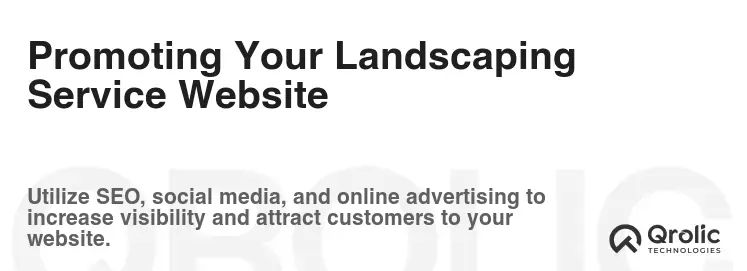
Once your website is live, it’s important to promote it to attract visitors and generate leads.
Search Engine Optimization (SEO) (Continued)
Continue to optimize your website for SEO to improve your rankings in search engine results pages. Monitor your rankings and traffic using tools like Google Analytics and Google Search Console.
Social Media Marketing
Create social media profiles for your landscaping business on platforms like Facebook, Instagram, and Pinterest. Share engaging content, including photos of your projects, tips and advice, and promotional offers. Run targeted ads to reach potential customers in your area.
Email Marketing
Build an email list by offering a free ebook, discount, or other incentive to website visitors who sign up. Send regular emails to your subscribers with valuable content, promotional offers, and updates about your business.
Online Advertising
Run online ads on platforms like Google Ads and social media to reach a wider audience. Target your ads based on demographics, interests, and location. Use compelling ad copy and visuals to attract clicks.
Local SEO
Optimize your website for local search by creating a Google My Business listing and getting citations from local directories. Encourage customers to leave reviews on your Google My Business page.
Networking
Attend local events and network with other businesses and homeowners. Share your website address and business cards with potential clients.
Maintaining Your Landscaping Service Website
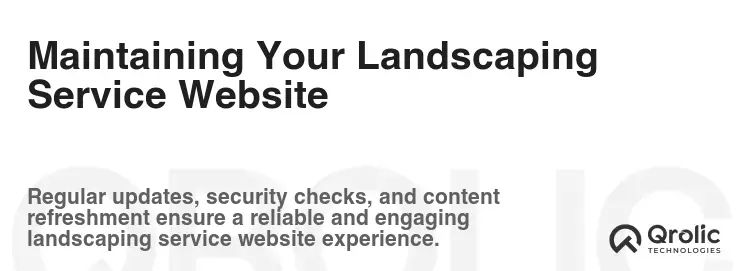
Maintaining your website is essential for keeping it up-to-date, secure, and effective.
Regularly Update Your Content
Keep your website content fresh and relevant by adding new blog posts, project photos, and testimonials. Update your service descriptions and pricing as needed.
Perform Security Updates
Install security updates for your website’s platform, theme, and plugins. Use a strong password and enable two-factor authentication to protect your account.
Monitor Website Performance
Monitor your website’s performance using tools like Google Analytics and Google Search Console. Track your traffic, rankings, and conversions. Identify areas for improvement and make necessary changes.
Back Up Your Website Regularly
Back up your website files and database regularly to protect against data loss. Store your backups in a safe and secure location.
Test Your Website Regularly
Test your website on different devices and browsers to ensure it functions properly. Check for broken links, errors, and other issues.
The Importance of Professional Photography for Landscaping Websites

High-quality photography is absolutely critical for a landscaping service website. Visuals are the first thing that catches a visitor’s eye and creates an impression. Investing in professional photography can significantly impact your website’s effectiveness and lead generation.
Showcasing Your Best Work
Professional photos allow you to showcase your best work in its best light. They capture the details, colors, and textures of your landscapes, creating a visually appealing portfolio that attracts potential clients. Poorly lit or blurry photos can detract from the beauty of your landscapes and make your work look unprofessional.
Building Trust and Credibility
High-quality photos convey professionalism and attention to detail, which builds trust and credibility with potential clients. They show that you take pride in your work and are committed to delivering exceptional results. Amateur photos can make your business look less established and reliable.
Attracting and Engaging Visitors
Visually appealing photos attract and engage visitors, encouraging them to explore your website and learn more about your services. They can also help to tell a story about your landscapes and the benefits they provide. Generic stock photos can be impersonal and fail to capture the unique qualities of your work.
Improving SEO
Optimizing your photos for SEO can help to improve your website’s ranking in search engine results pages. Use descriptive alt text for your images, including relevant keywords. Compress your images to reduce file size and improve website loading speed.
Driving Conversions
High-quality photos can help to drive conversions by showcasing the value of your landscaping services. They can inspire potential clients to envision the possibilities for their own landscapes and contact you for a consultation.
Types of Photos to Include:
- Before-and-After Photos: These are incredibly powerful for demonstrating the impact of your work.
- Finished Project Photos: Capture the beauty and functionality of your completed landscaping projects.
- Close-Up Photos: Highlight the details of your plants, hardscaping, and other features.
- Team Photos: Show the faces behind your business and build a personal connection with potential clients.
Qrolic Technologies and Your Landscaping Website

Qrolic Technologies (https://qrolic.com/) understands the unique challenges and opportunities that landscaping businesses face in the digital landscape. We offer a range of services designed to help you create a stunning, effective, and SEO-optimized website that attracts new clients and grows your business.
Our Services:
- Website Design and Development: We create custom websites that are visually appealing, user-friendly, and optimized for conversions.
- SEO Services: We help you improve your website’s ranking in search engine results pages, driving more organic traffic to your site. We focus on keywords relevant to landscaping service and outdoor design.
- Content Creation: We create engaging and informative content that attracts visitors and establishes you as an authority in the field.
- Social Media Marketing: We help you build a strong social media presence and connect with potential clients.
- PPC Advertising: We run targeted online advertising campaigns to reach a wider audience and generate leads.
Why Choose Qrolic Technologies?
- Industry Expertise: We have experience working with landscaping businesses and understand their unique needs.
- Custom Solutions: We tailor our services to meet your specific goals and budget.
- Results-Driven Approach: We focus on delivering measurable results that help you grow your business.
- Dedicated Support: We provide ongoing support and guidance to ensure your website is always performing at its best.
Let Qrolic Technologies help you create a website that showcases your expertise, attracts new clients, and grows your landscaping business. Visit our website at https://qrolic.com/ to learn more.
Legal Considerations for Your Landscaping Service Website
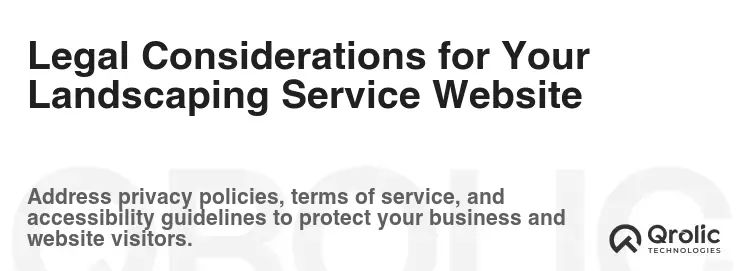
While creating a stunning and functional website is crucial, it’s equally important to ensure you comply with relevant legal requirements. Ignoring these considerations can lead to penalties, lawsuits, or damage to your business’s reputation.
Privacy Policy
- Why it’s necessary: If your website collects any personal information from visitors (e.g., name, email address, phone number), you’re legally obligated to have a privacy policy. This policy outlines how you collect, use, and protect this information.
- What to include: Disclose the types of personal information you collect, how you use it (e.g., for marketing, customer service), whether you share it with third parties, and how users can access or correct their information. Comply with relevant privacy laws like GDPR (if you have customers in Europe) and CCPA (if you have customers in California).
- Where to place it: Display a clear link to your privacy policy in the footer of every page on your website.
Terms of Service (Terms and Conditions)
- Why it’s necessary: While not always legally required, terms of service protect your business by outlining the rules and conditions for using your website. They can limit your liability and prevent misuse.
- What to include: Disclaimers about the accuracy of information on your website, limitations on your liability for damages, acceptable use policies (e.g., prohibiting illegal activities), and intellectual property ownership. If you sell products or services online, include terms related to payment, shipping, and returns.
- Where to place it: Link to your terms of service in the footer of every page on your website.
Copyright Information
- Why it’s necessary: Protect your original content (text, images, videos) from unauthorized use.
- What to include: Include a copyright notice in the footer of your website, typically stating “Copyright © [Year] [Your Business Name]. All rights reserved.” Ensure that you have the right to use all images and content on your website. Obtain licenses or permissions for any copyrighted material you use.
- Image Rights: Use stock photos from reputable sources, and make sure that you have the rights to use the pictures on your website
- Where to place it: The copyright notice is usually placed in the footer.
Accessibility
- Why it’s necessary: Make your website accessible to people with disabilities (e.g., visual impairments, hearing impairments). Accessibility is not only ethically important but also legally required in many jurisdictions.
- What to do: Follow the Web Content Accessibility Guidelines (WCAG) to make your website more accessible. Provide alternative text for images, use clear and readable fonts, ensure sufficient color contrast, and make your website navigable using a keyboard. Consider using accessibility testing tools to identify and fix accessibility issues.
- Disclaimer: Add an accessibility statement to your site, that makes it know that you are trying to make it accessible for everyone.
Disclaimer
- Why it’s necessary: Limit your liability for errors or omissions on your website.
- What to include: State that the information on your website is for general informational purposes only and should not be considered professional advice. Disclaim responsibility for any damages resulting from reliance on the information on your website.
Cookie Policy
- Why it’s necessary: If your website uses cookies (small text files stored on users’ computers) to track user behavior, you’re typically required to obtain user consent.
- What to do: Display a cookie banner or notification that informs users about your use of cookies and asks for their consent. Provide information about the types of cookies you use and their purposes. Allow users to manage their cookie preferences.
- Where to place it: Implement a cookie banner that appears when users first visit your website. Link to a more detailed cookie policy from the banner and the footer of your website.
Business Licenses and Disclosures
- Why it’s necessary: Ensure your website complies with any requirements to display your business licenses or registrations.
- What to do: Display your business license number or registration information on your website, if required by your local regulations. Clearly disclose your business name, address, and contact information.
Professional Advice
- Consult with a legal professional to ensure your website complies with all applicable laws and regulations. This is especially important if you operate in multiple jurisdictions or provide specialized services.
